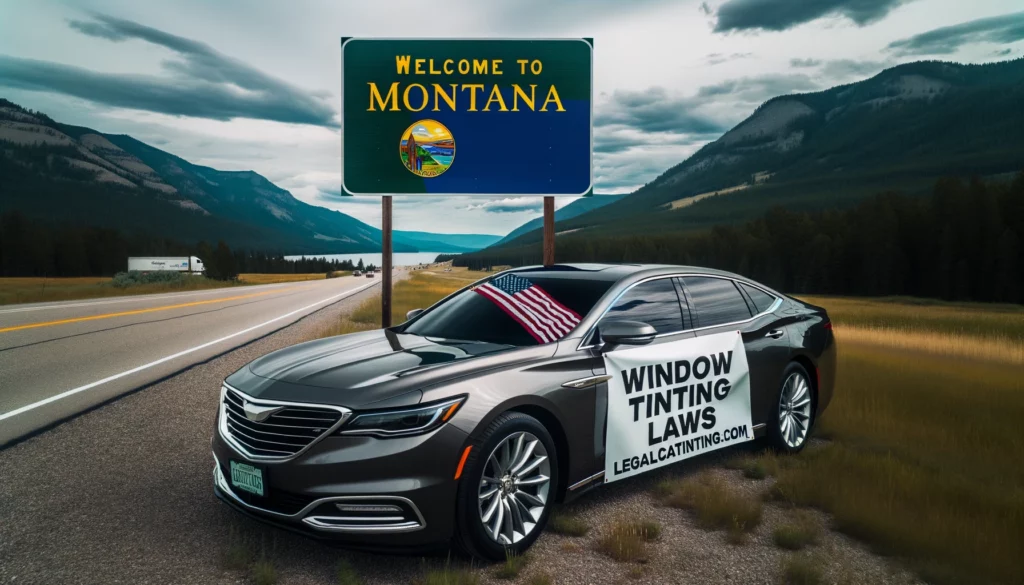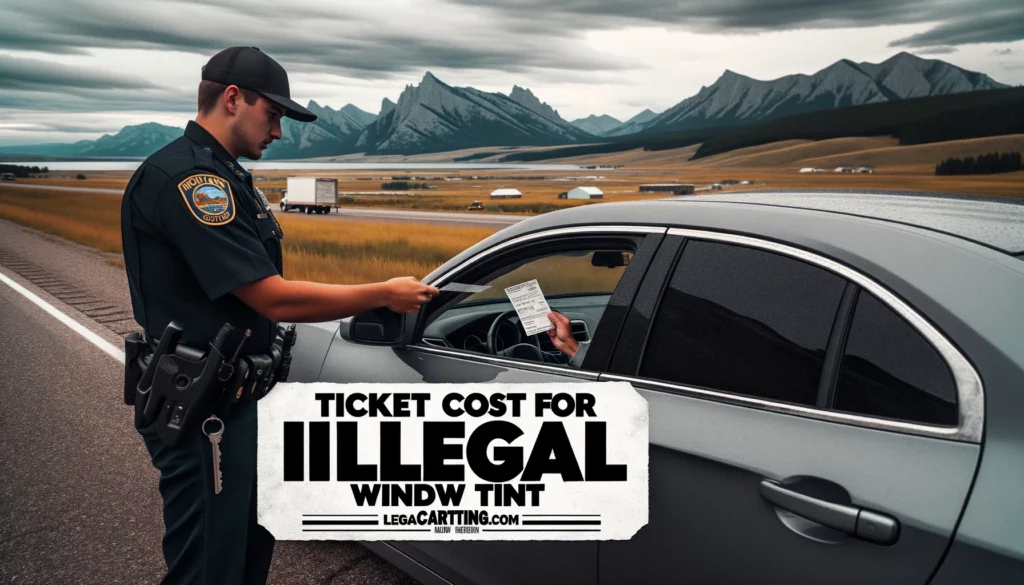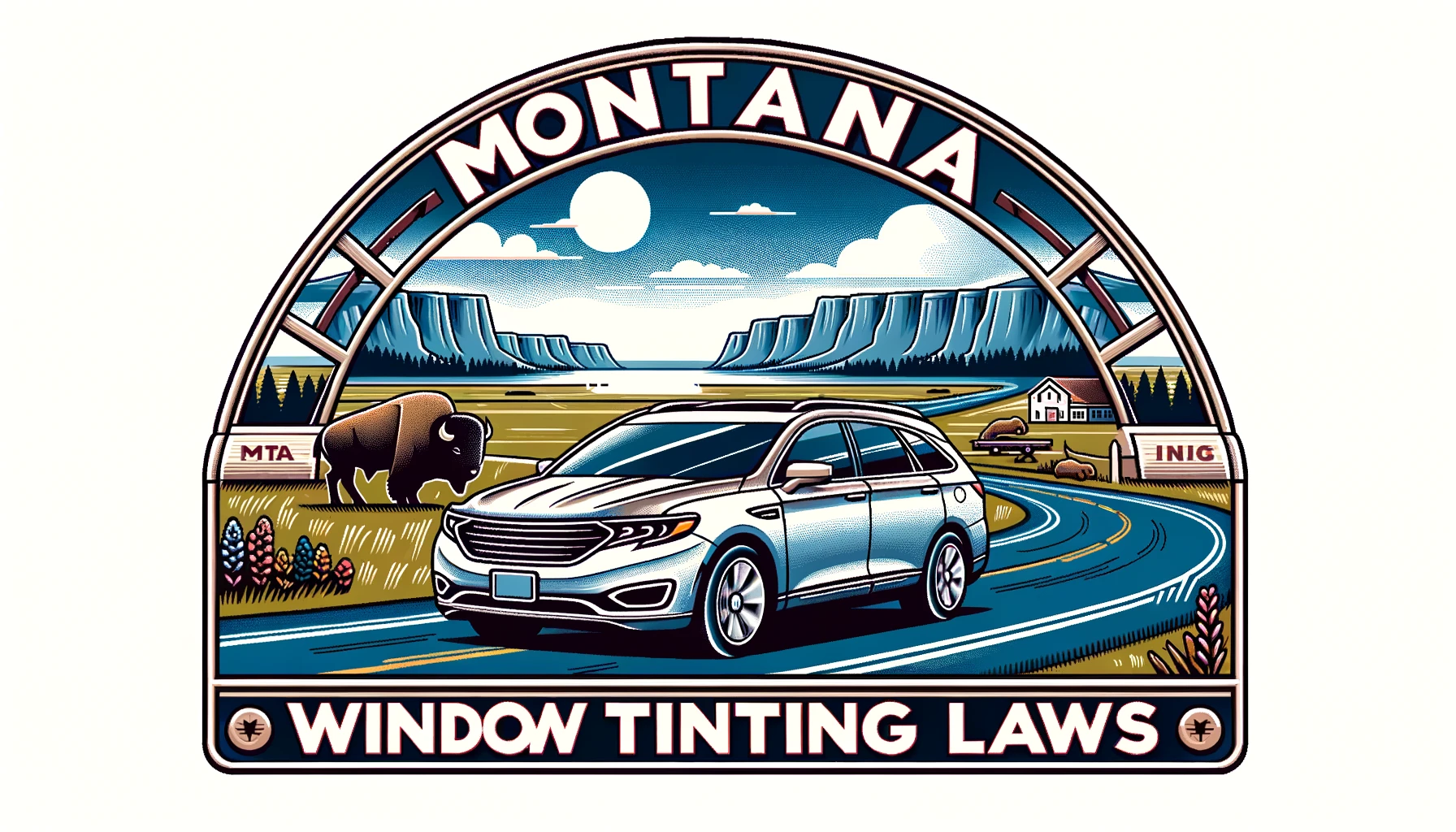Darkest legal tint for Sedans in Montana
- Windshield: Non-reflective tint is allowed above the manufacturer’s AS-1 line.
- Front Side windows: Must allow more than 24% of light in.
- Back Side Windows & Rear Window: Must allow more than 14% of light in.
Darkest legal tint for SUV and Vans in Montana
- Windshield: Non-reflective tint is allowed above the manufacturer’s AS-1 line.
- Front Side windows: Must allow more than 24% of light in.
- Back Side Windows & Rear Window: No specific darkness restrictions.
Montana Tinting Regulations

Montana first introduced its window tinting laws back in 1991. Since then, there have been amendments, with the most notable one in 2007. The state has been pretty consistent in ensuring the safety of its drivers while balancing the need for privacy and protection from the sun.
How Dark Can You Go?
The darkness of the tint is measured by the Visible Light Transmission (VLT) percentage. In simple terms, it’s the amount of light the tint allows to pass through. Montana has specific VLT percentages based on the type of vehicle
Reflecting on Reflection
Apart from the darkness, there’s also the matter of reflection. Some tints can reflect incoming light, which can reduce glare and heat. However, Montana has set limits to ensure it doesn’t become a hazard:
- Both for sedans and SUVs/vans, the front and back side windows must not be more than 35% reflective.
Colors and More
While you might be tempted to match your tint with the color of your car, Montana has some restrictions. Red, yellow, and amber tints are a no-go in the state. It’s essential to keep this in mind to avoid any legal complications.
Other Noteworthy Points
- Side Mirrors: Montana is pretty relaxed when it comes to side mirrors. There are no specific restrictions, giving car owners a bit more flexibility.
- Stickers: While the state law recommends it, there’s no strict requirement to have stickers identifying legal tinting. It’s more of a “good to have” than a “must-have.”
- Medical Exemptions: For those with specific medical conditions that require added protection from sunlight, Montana does allow for special tinting exemptions. However, it’s crucial to consult the state law for the exact terms of this exemption.
- Penalties: No one likes penalties, right? In Montana, violating the window tinting laws can lead to a misdemeanor. This could mean a fine of up to $500 or even up to 6 months in county jail. So, it’s always better to be on the right side of the law!
Medical Exemptions for Montana Tint Laws

Window tints serve more than just an aesthetic purpose. They can protect against harmful UV rays, reduce glare, and provide privacy. For individuals with certain medical conditions, these benefits aren’t just a luxury; they’re a necessity. Conditions such as lupus, photosensitivity, or melanoma can make individuals more susceptible to the harmful effects of direct sunlight. Recognizing this, Montana has provisions in its window tinting laws to accommodate such needs.
What Montana’s Law Says
Montana allows for medical exemptions to its standard window tinting regulations. This means that if you have a qualifying medical condition, you can have darker tints than what’s generally permitted. However, it’s not as simple as just claiming you have a condition. There are specific steps and criteria to meet:
- Documentation: You’ll need a signed document from a licensed physician stating the medical necessity of having darker window tints. This document should clearly mention the nature of the condition and why darker tints are essential for the patient’s well-being.
- Validity: The medical exemption is not a one-time pass for life. It has a validity period, after which you’d need to renew it. Always keep an eye on the expiration date to ensure you’re compliant with the law.
- Tint Darkness: Even with a medical exemption, there might be a limit to how dark your tints can be. It’s essential to consult with the local DMV or law enforcement agencies to understand the exact specifications allowed under the exemption.
How to Apply
If you believe you qualify for a medical exemption, here’s a step-by-step guide:
- Consult Your Doctor: Before anything else, discuss your condition and the need for darker window tints with your physician. They’ll be able to guide you on whether an exemption is necessary and provide the required documentation.
- Visit the DMV: With your doctor’s note in hand, head to your local DMV. They’ll have a specific form for medical exemptions related to window tinting. Fill it out, attach the doctor’s note, and submit it for review.
- Wait for Approval: Once submitted, there will be a review process. If approved, you’ll receive an exemption certificate, which you should always keep in your vehicle. This will be crucial if you’re ever stopped by law enforcement.
A Few Things to Remember
- Stay Updated: Laws and regulations can change. It’s always a good idea to stay updated with any modifications to the medical exemption rules.
- Respect the Law: Just because you have an exemption doesn’t mean you can go as dark as you want with your tints. Always adhere to the specifications mentioned in your exemption certificate.
- Renewals: As mentioned earlier, these exemptions aren’t forever. Ensure you renew them as needed to stay compliant with Montana’s laws.
Window Film Certificates and Stickers In Montana
In many states, manufacturers of window film are required to certify the film they sell, ensuring it meets specific standards. This certification often comes in the form of a certificate, which can be presented upon request to show that the film is compliant with state regulations.
However, Montana takes a more relaxed approach. The state does not mandate manufacturers to certify the window film they sell. This means that if you’re purchasing window film in Montana, it’s on you, the consumer, to ensure it meets the state’s tinting regulations.
What About Stickers?
Stickers are a bit different from certificates. While a certificate is typically a document proving the film’s compliance, a sticker is a small decal placed on the vehicle, usually on the driver’s side window. This sticker indicates that the vehicle’s tints are within legal limits.
In Montana, the state law recommends the use of such stickers to identify legal tinting. However, it’s essential to note that while recommended, these stickers are not a strict requirement. If you decide to use one, it can act as a quick reference for law enforcement, potentially saving you from unnecessary stops or questions about your window tints.
A Few Tips for Montana Drivers
- Do Your Research: Even though Montana doesn’t require film certification, it’s a good idea to purchase from reputable manufacturers or suppliers. They’ll often provide information about the film’s VLT (Visible Light Transmission) percentage, ensuring you stay within legal limits.
- Consider Using a Sticker: While not mandatory, having a sticker can be beneficial. It’s a quick way to show law enforcement that you’re compliant with state regulations, potentially saving you time and hassle.
- Stay Updated: Regulations can change. It’s always a smart move to stay updated with Montana’s window tinting laws, ensuring you’re always in compliance.
Penalties or Ticket Cost for Illegal Window Tint in Montana

Before we dive into the penalties, it’s essential to understand why these regulations exist in the first place. Window tints, while beneficial in blocking harmful UV rays and reducing glare, can pose safety risks. If tints are too dark, they can hinder a driver’s visibility, especially during nighttime or adverse weather conditions. Moreover, for law enforcement, overly dark tints can prevent officers from seeing inside a vehicle, posing potential security risks.
The Cost of Non-Compliance
In Montana, if you’re found to have illegal window tint, it’s not just a slap on the wrist. The state takes these violations seriously:
- Misdemeanor Offense: Illegal window tinting is classified as a misdemeanor in Montana. This means it’s more severe than a simple traffic infraction and can have more lasting consequences.
- Fines: If you’re caught with illegal tint, you can be slapped with a fine. The exact amount can vary based on the severity of the violation and whether it’s a repeat offense. However, fines can go up to $500, making non-compliance a costly affair.
- Potential Jail Time: Believe it or not, illegal window tint can land you in jail in Montana. While it might sound extreme, repeat offenders or those with significantly dark tints can face up to 6 months in county jail.
- Removal of Tint: In addition to fines and potential jail time, you might be required to remove the illegal tint from your vehicle. This can be an added expense, especially if you’ve invested in high-quality tinting.
Avoiding the Penalties
The best way to avoid these penalties? Stay informed and compliant. Here are a few tips:
- Know the Limits: Familiarize yourself with Montana’s window tinting regulations. Understand the allowed Visible Light Transmission (VLT) percentages for different parts of your vehicle.
- Work with Professionals: If you’re getting your windows tinted, choose a reputable service provider familiar with Montana’s regulations. They’ll ensure your tints are within legal limits.
- Regular Checks: Over time, window tints can fade or change. It’s a good idea to get them checked periodically to ensure they remain compliant.
- When in Doubt, Ask: If you’re unsure about the legality of your window tints, don’t hesitate to consult with local law enforcement or the DMV. They can provide guidance and ensure you’re on the right track.
Conclusion
Montana, often dubbed “Big Sky Country,” is a state that seamlessly blends natural splendor with rich history and cultural vibrancy. From its majestic Rocky Mountains to its bustling tech hubs, Montana embodies the spirit of both the Wild West and modern-day America. A visit to this state promises not just scenic beauty but also a deep dive into the heart of American traditions and innovations.
State of Montana Info
Ah, Montana! A state that often evokes images of vast open spaces, rugged mountains, and the untamed wilderness. But Montana is so much more than just its landscapes. It’s a state rich in history, culture, and a spirit of adventure. Let’s embark on a journey to discover the essence of Montana.
A Glimpse into Montana’s Geography
Montana, fittingly nicknamed “Big Sky Country,” is the fourth largest state in the U.S. It’s bordered by Idaho to the west, Wyoming to the south, North Dakota and South Dakota to the east, and Canada to the north. With its diverse terrain, Montana boasts everything from the Rocky Mountains to the Great Plains.
A Dive into History
The history of Montana is as vast as its landscapes. Before European exploration, the region was home to indigenous tribes like the Crow, Cheyenne, and Blackfeet. The Lewis and Clark Expedition in the early 1800s marked a significant turning point, paving the way for settlers. The discovery of gold in the mid-19th century further accelerated Montana’s growth, bringing in a wave of prospectors and settlers.
Economy and Industry
While Montana’s early economy was dominated by mining, especially gold, silver, and copper, it has since diversified. Agriculture plays a significant role, with the state being a leading producer of wheat, barley, and beef. Forestry, tourism (thanks to gems like Glacier National Park and Yellowstone), and a growing tech industry in cities like Missoula and Bozeman also contribute to Montana’s economic landscape.
Cultural Vibrancy
Montana is not just about its physical beauty; it’s also a hub of cultural activity. From the annual Crow Fair, one of the largest Native American events in the country, to the vibrant arts scene in towns like Livingston, Montana is a melting pot of traditions, arts, and festivals.
Education and Institutions
Montana places a strong emphasis on education. The state is home to the University of Montana and Montana State University, among other institutions. These universities not only serve as educational hubs but also contribute significantly to research, especially in areas like agriculture and environmental science.
The Spirit of Adventure
If there’s one thing Montana promises, it’s adventure. Whether you’re hiking in the Bitterroot Mountains, fishing in the pristine rivers, or skiing in places like Big Sky, Montana offers a plethora of outdoor activities. It’s a haven for those with a spirit of adventure and a love for the great outdoors.
Frequently Asked Questions
What is the history of window tinting laws in Montana?
Car window tinting laws in Montana were enacted in 1991 and amended in 2007.
Are there any restrictions on window tint colors in Montana?
Yes, red, yellow, and amber tints are not allowed in Montana.
Do manufacturers of tint film need to certify their products in Montana?
No, manufacturers of film do not need to certify the film they sell in the state.
Is there a recommendation for stickers to identify legal tinting in Montana?
State law recommends, but does not require, stickers to identify legal tinting.
Are there any restrictions on side mirrors in Montana related to window tinting?
No, there are no restrictions on side mirrors in Montana.
